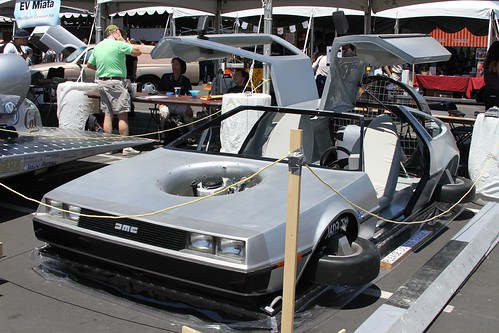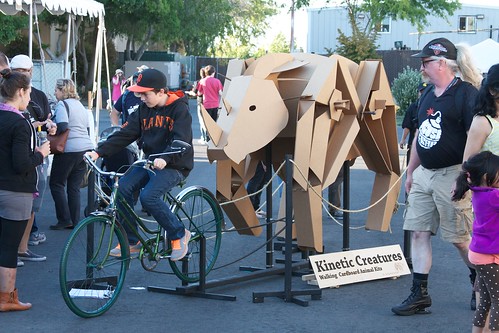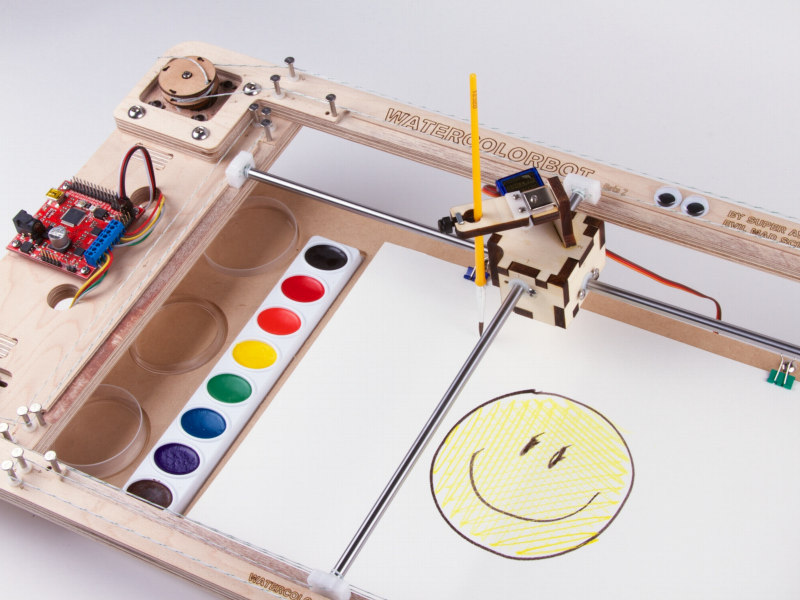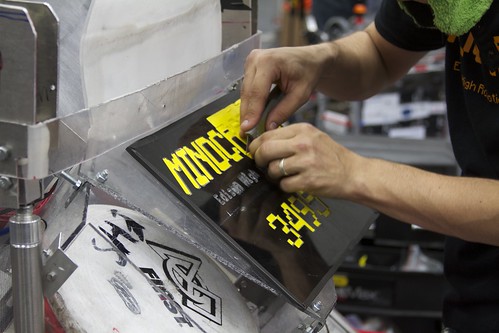Tickets to attend the 2013 Open Hardware Summit are now available for purchase.
The Summit takes place on September 6 at MIT. The call for papers and the call for sponsors are both still open as well.
Photo credit: Open Hardware Summit on Flickr.




Tickets to attend the 2013 Open Hardware Summit are now available for purchase.
The Summit takes place on September 6 at MIT. The call for papers and the call for sponsors are both still open as well.
Photo credit: Open Hardware Summit on Flickr.

Fern Canyon is a lush little feature of Prairie Creek Redwoods State Park— a tiny winding canyon whose dripping walls are lined with soft ferns and vibrant mosses.
The park is located very northwest corner of California, nestled against Redwood National Park. The two parks are managed together, as part of the “Redwood National and State Parks.” It’s a substantial six hour drive north from San Francisco or Silicon Valley, but as you will see, it’s unique, and arguably worth the trip.
As the review chair for this year’s Open Hardware Summit, I’m very pleased to announce that the call for papers is now open:
The Open Source Hardware Association invites submissions for the fourth annual Open Hardware Summit, to be held September 6, 2013 at the Massachusetts Institute of Technology.
The Open Hardware Summit is the world’s first comprehensive conference on open hardware; a venue to discuss and draw attention to the rapidly growing Open Source Hardware movement. The Open Hardware Summit is a venue to present, discuss, and learn about open hardware of all kinds. The summit examines open hardware and its relation to other issues, such as software, design, business, law, and education.
We are seeking proposals for talks, posters, and demos from individuals and groups working with open hardware and related areas.
Submissions are due by JUNE 21, 2013. Please see the complete call for papers for additional details.
The 2013 Open Hardware Summit has also opened its call for sponsors; please click here if you are interested in helping to sponsor the summit.
Photo credit: Open Hardware Summit on Flickr.
The 2013 Bay Area Maker Faire is a wrap— and it was amazing. And we took pictures. We’ve uploaded 362 photos from maker faire right here for your browsing pleasure. But first, a little preview.
Kids play with giant cardboard robot arms at the Giant Cardboard Robots booth. As they say, “The revolution will be corrugated.”
Glo-Puter Zero, by Alan Yates, with its phosphor-based memory. Truly a highlight of the show.
Lenore shares a nerdy moment with Akiba from Freaklabs.
An unusual LED badge, from the Bay Lights project.
The Western Pyrotechnics Association is a club for people that make their own fireworks. It’s incredible to see the complexity and artistry of the fireworks and the tooling that makes them.

A beautiful hovercraft, designed to look like a flying DeLorean; you can see video of it on the project site.
Back at our booth, the WaterColorBot was a constant hit. Above, Sylvia shows visitors how to sketch with it in real time.
An unexpected application: Our friend Bilal Ghalib stopped by and enlisted the WaterColorBot to help him make a birthday card for another friend.
And one of our favorite moments of Maker Faire: a young visitor, tickled pink as she tries out the WaterColorBot, watching it paint a drawing that she had just sketched.

A bicycle-powered cardboard walking rhino, by Kinetic Creatures, makers of walking cardboard robot kits, with Theo Jansen inspired walking mechanisms.
Some of the creations are simpler, like this sidewalk-chalk wielding vibrobot, spinning on a tabletop chalkboard at the Exploratorium booth.
Some of the creations are more technical, like the OpenPNP project to create open source pick and place machines for electronics assembly. We’re excited by where this is headed, along with a few related projects.
And of course, there’s no shortage of LED goodness.
Please click right here for the rest of our 2013 Bay Area Maker Faire photo album.
This is a fantastically busy week in the bay area for makers and hardware folk.
On Tuesday and Wednesday, the Hardware Innovation Workshop will be held at San Mateo College. Windell will be speaking on Wednesday afternoon; check out the agenda to see the full lineup of presenters.

On Thursday, we’ll be participating in Maker Faire Education Day with Super Awesome Sylvia and the WaterColorBot. If you’re a bay area teacher, you and your class should be there! If you’re a bay area student, make sure your teacher knows about this!
On Saturday and Sunday, the Bay Area Maker Faire is in full swing at the San Mateo County Event Center. We’ll be there with Super Awesome Sylvia and the WaterColorBot. Windell and I also mentor FIRST Robotics team 3501 from Fremont High School in Sunnyvale, and they will be there with their robot, Oddjob. I will be participating in the Parenting Young Makers panel on the Make: Education Stage at 2:00 pm on Sunday as well. The full Maker Faire schedule has been posted, and advance tickets are still available. If you’re planning on driving, check out the list of free parking lots with shuttles or in walking distance. 110,000 attendees were there last year— not a small party!
To spread the celebration a little further, we’re holding a DIY Fever sale in our shop now through Monday.

Congratulations to Sylvia on her participation in this fantastic event! We’ll add to this list as we find more articles and links.
We are right in the middle of National Robotics Week, which runs April 6-14 and starts a string of events all over the country for makers of all kinds. We’ve listed a few upcoming highlights below:
You can look for events in your area on the National Robotics Week Events site and the Maker Faire Map site—feel free to add your favorites in the comments. We’ll be exhibiting at RoboGames and helping Super Awesome Sylvia show off the Watercolorbot at Maker Faire. We hope to see you there!
We have been visiting the Exploratorium in San Francisco again and again since we were teenagers in the early ’90s. And with good cause: The Exploratorium is an unparalleled museum of hands-on science, art, perception, and exploration. It’s not a children’s museum (although it is an amazing place to take children), nor is it a place where you admire giant fossilized skeletons, nor one of those museums that always seems to have a traveling exhibit with a name like “The Science of Jersey Shore.”
Instead, it’s a place full of simple, often-amazing yet not-too-flashy exhibits that (for the most part) you play with to learn about various phenomena. For example, at the Floating in Copper exhibit, you can get a feel for the un-earthly effects that strong magnets have in the presence of a large block of nonmagnetic, highly-conductive material. It’s one thing to read about eddy currents in an article; it’s quite another to release a chunk of metal in mid-air, only to find that it floats down to rest, more gently than a dandelion seed. You may have seen this exact exhibit at other museums (here, for example)— and if so, that’s quite likely because the Exploratorium makes many copies of its exhibits for other museums and publishes plans for others to make their own.
Since moving to the Bay Area in 2005 and starting the Evil Mad Scientist Laboratories blog, we’ve also been honored to present some of our own projects at Exploratorium events over the past few years, including the CandyFab, a Bristlebot workshop at the first Young Makers event, and some of our clock projects at the Open Make event on the theme of “Time.”


The Exploratorium has, since its founding in 1969, been located in the exhibit hall of the the Palace of Fine Arts— a huge arc of a building left over from the 1915 Worlds Fair, located in the Marina district of San Francisco, as pictured above. As the name implies, the building was designed to be a museum and was a remarkably suitable home for the Exploratorium. However, a few years ago, it came out in the news that they would be moving out of the Palace of Fine Arts, and into a space on one of the San Francisco Piers. Of course, our hearts sank at hearing this, as we could not imagine any more perfect place for the Exploratorium. Nor could we imagine that they could possibly find a place as large and welcoming anywhere else in San Francisco. We were also worried about parking, as the Palace of Fine Arts was blessed with its own parking lots, a rarity in San Francisco.
We were wrong.
The new location at Piers 15 and 17 on the San Francisco Embarcadero is right between the Ferry Building and Fisherman’s Wharf, in the shadow of the Bay Bridge. A huge advantage of the new location is that it is much easier to get to by public transport than the Palace of Fine Arts was. There’s a MUNI train stop, and it’s just a few blocks from BART and the other public transportation that already comes to the Ferry Building.
There are also plenty of nearby parking garages and lots. We had no problem finding an inexpensive lot to park in for the day, and now taking the train is an option for us.
The new location is much bigger: there is three times as much space. This view is looking down one of the corridors, from the location pictured previously. The museum is packed with exhibits as far as the eye can see.
All of the spaces are well designed, and extremely good looking, taking advantage of the abundant natural light.
There are many large open areas, as well as cozy corners and nooks. The Tactile Dome is being rebuilt on a larger scale (in a space with a higher ceiling than this) and will be opening this summer.
Activity in the new bio labs is visible through large windows. In neighboring spaces, we saw them growing continuous replacement plants for the touchable plant exhibits and various organisms for people to look at under the microscopes.
The new location has the same spirit, and despite our expectations, still feels like the Exploratorium. The workshop is just as prominent as before, and still out in the open so that visitors can see new exhibits in progress and old ones being repaired.
Our old favorites on electricity and magnetism (like Daisy Dyno) felt right at home, and were as popular as ever.
The acoustics are much more friendly, making conversations and discussions much more enjoyable.
The one new building on the pier is the Bay Observatory, which has stunning views as well as brand new exhibits on bay topics such as geology, geography and tides. Above is a 3D tide table with the tides for each day represented by a the shape of each piece of plastic marked with the time and lunar information.
Since this was an early preview, many exhibits are still in progress or yet to be installed. This outdoor space between Piers 15 and 17 will be opening soon and the museum plans to eventually develop additional space on Pier 17.
Congratulations to the Exploratorium on such a successful move and wonderful new home!
The museum will be opening to the public on April 17, and tickets will be available online soon. There are additional member previews coming up on April 6 and 9 as well— check the calendar for details and other upcoming events.
We spent this past weekend in Madera, California at the 2013 Central Valley FRC Regional, a FIRST robotics competition. We went with Firebird Robotics Team 3501 from Fremont High School, who we are mentoring and sponsoring.
The challenge of this year’s game, entitled Ultimate Ascent was to build a robot that could compete to score points on a team with two other robots by shooting frisbees into goals and climbing a pyramid structure while defending against an opposing alliance of three robots.
The Firebirds named their frisbee shooting robot “Oddjob” after the James Bond villain who throws his bowler hat with lethal results. One of the green-shirted safety advisors at the event was coincidentally named James Bond, and he was a good enough sport to allow us to take his picture with Oddjob.
We ran into a robot from team 840 sponsored by our friends at Skallops which had a wonderfully appropriate warning sticker on the frisbee shooter reading “DANGER: DECAPITATION HAZARD.”
We’re relatively new to the world of FIRST, which can be almost cult-like, with participants identifying themselves by team number like a code word or secret handshake. A smaller number means a team that was established earlier. Over the last 20 or so years, the organization has managed to channel the enthusiasm of teenagers which is normally directed toward athletes and celebrities instead toward engineering, programming, and building. The teams are fiercely spirited, bringing their mascots and supporters to cheer them on at competitions. It is truly incredible to see this much energy directed towards a science and engineering event.

Robots are awarded more points for goals scored during autonomous play, and the highly competitive field is steered toward collaboration and mutual assistance by the alliance aspect. The teams work hard to make sure that their robot will be an asset to any alliance in the hopes that even if they don’t rank highly enough in qualification rounds to be a team captain themselves, they’ll be chosen by one of the alliance captains and advance to the finals. They actively share tools and materials with the other teams, as any of the other robots could be on their alliance during a given match. Parts request announcements in the pits are filled almost as soon as they are announced, although when we heard “Team #### needs an FTL drive” over the PA, we could only laugh.
One of the more visible ways we were able to share was with our yellow gaffers tape, which team 3495 used to make their engraved sign stand out with their team color. We were the beneficiaries of parts, too, with another team generously sharing a metal shaft when one of ours bent during a match.
The teams are typically student driven, with mentors playing an advisory role, supporting the students as they work through problems of design, mechanics, building, programming, and team dynamics. The students work incredibly hard to design and build the robot during just six weeks allowed as the “build season,” and then during the competitions fine-tune, fix, and improve their machine. Even the mascot works just as hard on the robot as everyone else.
Through a combination of determination, hard work and luck, our team came out of the qualifying rounds with the top ranking, and then made it all the way to the final game of the elimination rounds, with their ally teams 3970 and 2643. However, our friends from team 840, along with allies 295 and 1678 bested us to win the finals, 2 matches to 1, earning a spot at the championships.
Besides strict competition, there are additional awards and honors are given at these events to recognize technical ingenuity, good design and spirit. Our team received the Judges award, which was summed up rather accurately by one team member as being the award for “general awesomeness.” Congratulations to all of the participating teams, every one of which pulled off building a robot that could play an incredibly challenging game! Our team is headed next to the Silicon Valley Regional event April 4-6, but there are events every week all over the world leading up to the championships April 24-27 in St. Louis. All events are free and open to the public, so get out and cheer on your local robots!
If you have a chance, find a way to mentor, sponsor, or otherwise volunteer to help out your local robot team or competition. FIRST, and its several associated programs directed at younger students, are some of the best ways that we have to inspire youngsters to pursue careers in science and engineering. And that’s something that benefits us all.
This weekend, Saturday and Sunday, October 20-21, 2-7 pm is ComBots Cup VII at the San Mateo Fairgrounds. ComBots is the heavyweight championship for combat robotics and is one of the loudest, most entertaining robotics competitions there is.
Teams from all over the US, Canada and Brazil will be coming to California to fight for The ComBots Cup – the annual international robot combat championship now in its seventh year. The ComBots Cup is to fighting robots what the World Series is to baseball. The two-day event features robots weighing up to 220 pounds fighting to be crowned the world heavyweight champion.
To get a taste of it, check out the video above, which is one in a series from earlier events. You can get your tickets online now. We’ll hope to see you there!